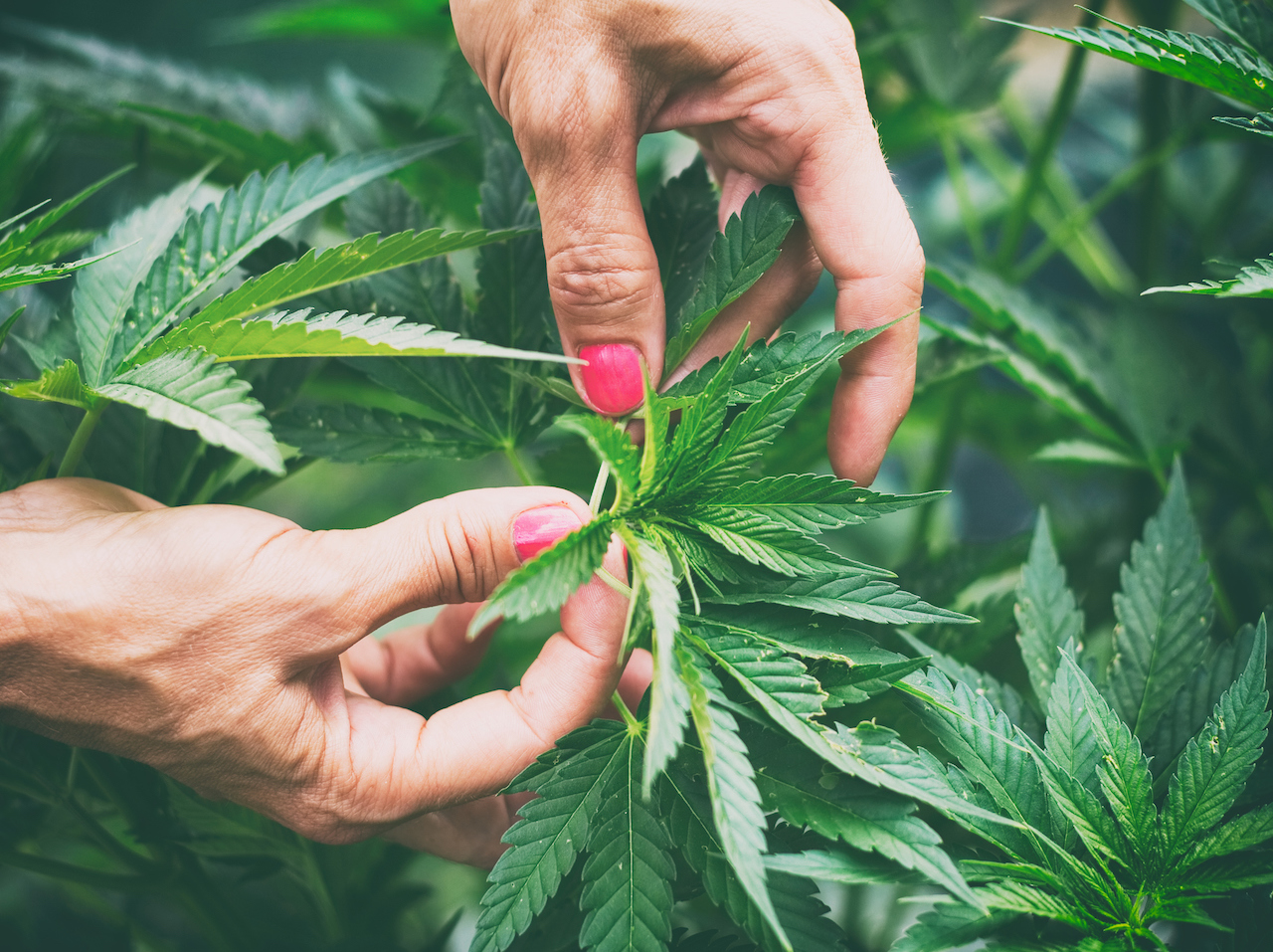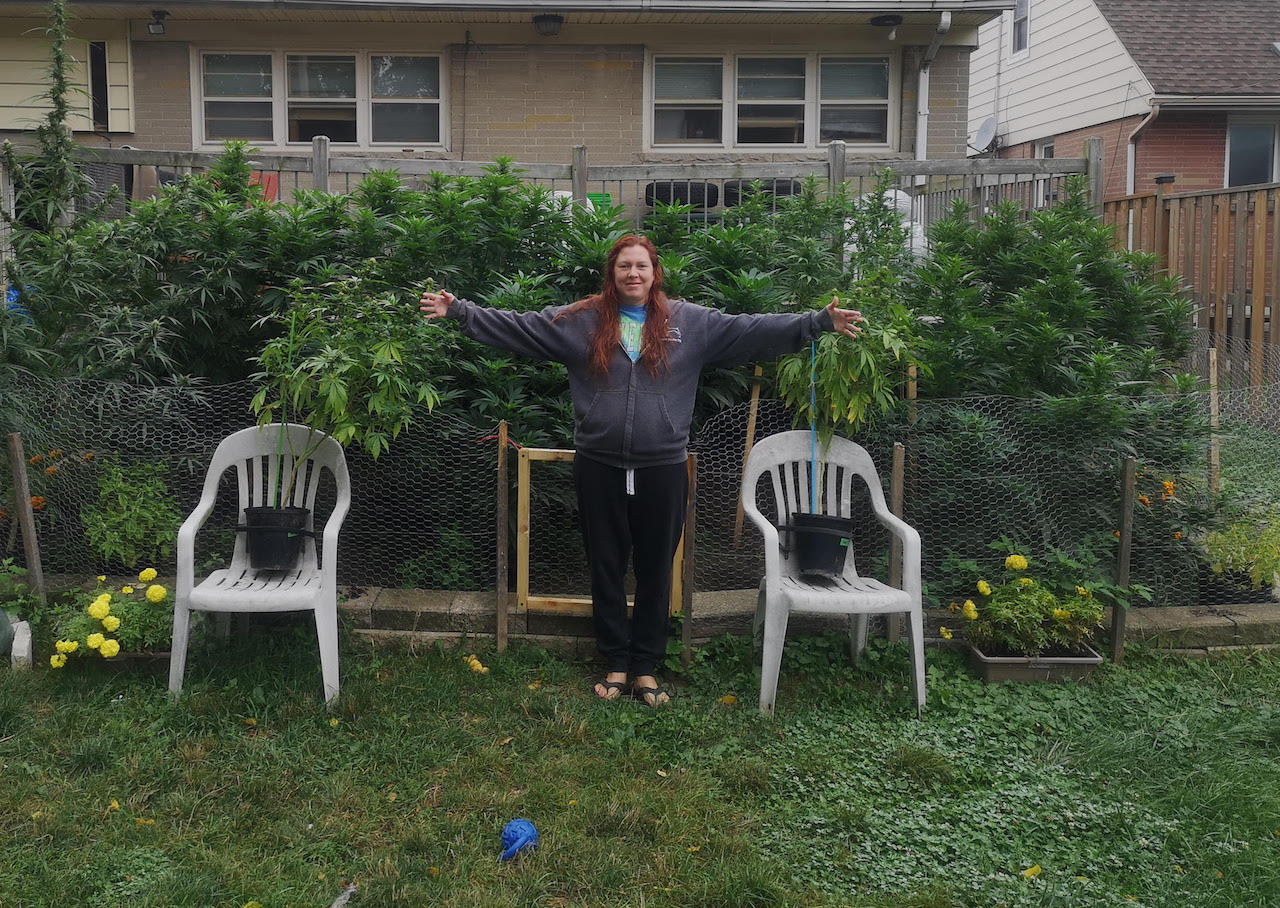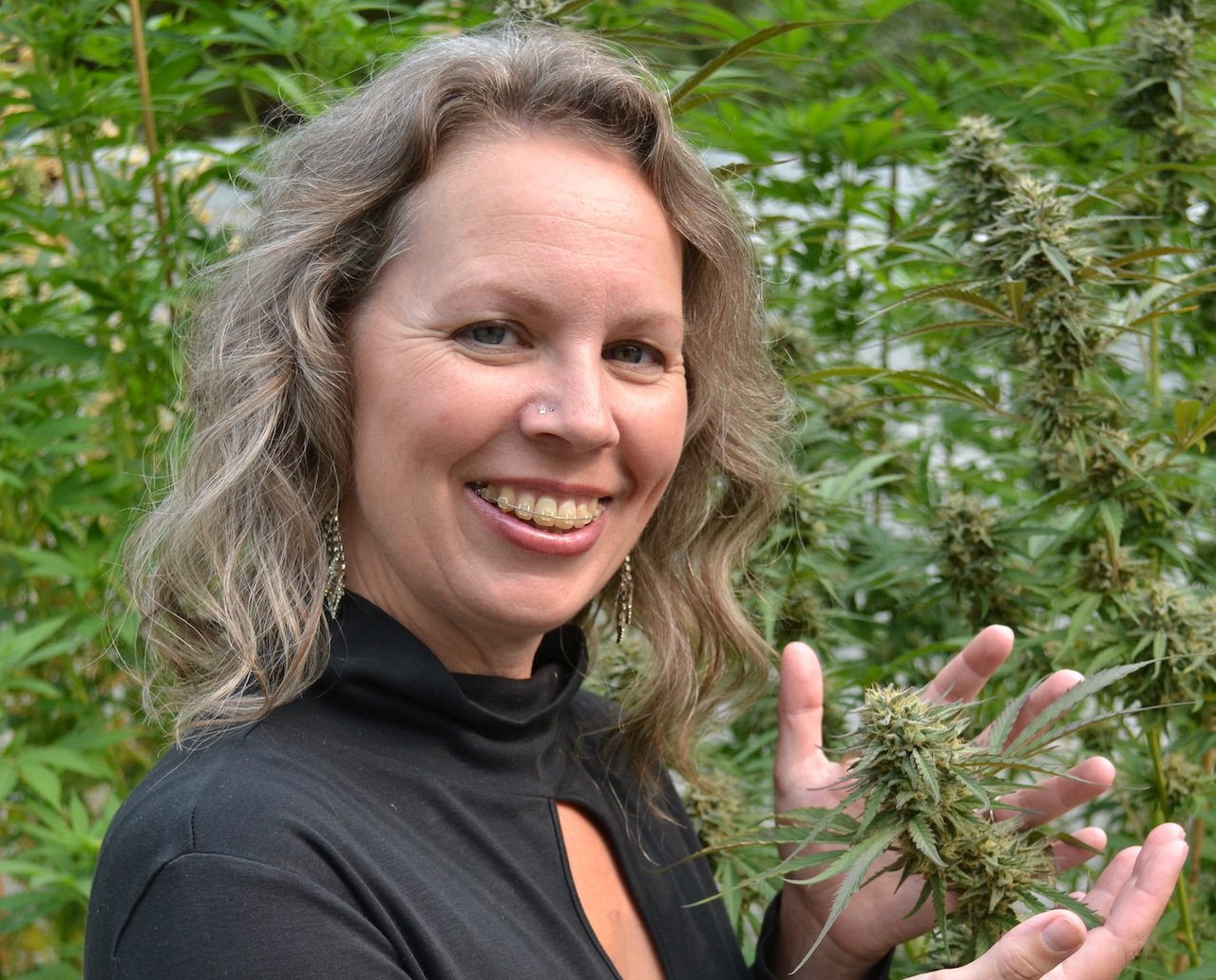How To Plant, Tend And Harvest Your Own Cannabis

After years of trying to participate in male-dominated online cannabis growing communities, April Brett was done with the disrespect that was directed at her just because she was a woman. So, in February 2020, she decided to create her own Facebook group: O’Cannabis: Canadian Ladies Growing Together.
“I wanted to create a group just for women where they can feel safe and have no drama and learn to grow,” says Brett, who lives and grows in Hamilton, Ont. “We build each other up and support each other, which is what women are supposed to do.”
Brett’s timing was impeccable. A month after she launched her group, pandemic lockdowns swept across the country and people started picking up home-based hobbies to stave off stress and boredom, and looking for community online. Many women decided to plant pandemic gardens with cannabis, and Brett watched her membership shoot up by the hundreds to more than 3,500 today.
“Growing is so therapeutic,” says Brett, who uses cannabis to manage her anxiety, depression, migraines and chronic pain. “It’s a huge stress reliever. I feel so at peace when I’m in my garden, watching my plants grow and flourish.”Brett sees many benefits to growing her own cannabis: it tastes better and is less expensive than buying it from dispensaries or medical cannabis suppliers and she knows exactly what she’s getting and what she put into it. She notes that commercial growers may use chemical fertilizers, pesticides and mold inhibitors—and consumers have no way of knowing. (Health Canada regulates the use of these substances and requires licensed producers to have their products tested.)
While growing cannabis may seem daunting, Brett says it’s simple if you follow a few basic principles. “People who can’t keep houseplants alive can grow cannabis,” she says. “Just keep it simple.”
Terese Bowors, a cannabis coach based in Canada’s cannabis growing capital, Nelson, B.C., echoes Brett. “If you can grow tomatoes and lettuce, you can grow cannabis,” she says.
We got the dirt on what you need to know to take your pandemic garden to a higher level from women in the know.

April Brett.
Understand the rules
Under the federal Cannabis Act, you can grow up to four cannabis plants for recreational use per household. But some provincial, local and Indigenous governments, as well as landlords and stratas, have their own rules.
Manitoba and Quebec prohibit recreational growing. But in 2019, a Quebec Superior Court judge ruled that the province’s ban was unconstitutional. The Quebec government has appealed the ruling and its website still says recreational growing is a no-no, but Éducaloi, a Quebec charity working to improve legal literacy, says green thumbs are good to grow—for now. “If you decide to grow cannabis at home, be sure to stay up to date on any changes!” Éducaloi cheerfully cautions on its website.
Meanwhile, Newfoundland and Labrador doesn’t allow outdoor growing and other provinces have strict guidelines on how it can be done. In B.C., for instance, your crop can’t be visible to the public, while in New Brunswick, your secret garden must be surrounded by a locked enclosure that’s at least five feet tall.
Bowors put deer fencing around her garden and lined it with light, white gardening fabric. “It looks like a big marshmallow,” she says, adding that the fabric also traps the heat, which the plants like.
If you use cannabis for medical reasons, you may be able to get a prescription from a health care provider and a medical certificate to grow, which may allow you more than four plants. (There are many medical cannabis clinics that can help you with the process.) The number of plants you can grow is based on the number of daily grams you’re prescribed and whether you plan to grow inside, outside or both.
It’s only legal to grow cannabis from seeds or small plants called clones purchased from licensed retailers or producers or gifted to you by legal recreational growers. Recreational growers can purchase seeds from licensed retailers for about $30 to $60 for a pack of four. Clones are slowly coming on the rec market and go for about $40 a pop. Medical growers can get their starting materials from licensed producers and access better bulk prices and more variety in clones.
While there are dozens of online seed banks selling a much wider variety of seeds for cheaper than licensed retailers and producers, it’s important to note that they’re not legal. Ashleigh Brown, founder of SheCann, a digital network for women interested in medical and legal cannabis, cautions that when people buy off the illicit market, they may not be getting what they think and could end up with a much stronger strain, likening it to “a bottle of wine rather than a light beer.”
Select your strains
There are hundreds of strains of cannabis, though only dozens available through licensed retailers and producers. Mikela Moore, a Chilliwack, B.C., grower and O’Cannabis group administrator, says women can avoid decision fatigue by considering two key things: what kind of high you want and your climate, as well as the two main subspecies: indica and sativa.
In general, indicas ground you with a heavy body stone, while sativas lift you up with an energizing head high. There are also hybrids, which are somewhere in between.
“They like to say, ‘Indica put you in-da-couch,’” says Moore, who has a medical certificate to grow cannabis to help treat her insomnia. “Whereas with sativas, you’re going to be able to do your cleaning or go out for a walk.”
Sativas are typically taller and thrive in warm, wet, humid areas and have longer growing seasons. Indicas, on the other hand, are bushier and can better withstand the cold and have shorter growing seasons. There are also ruderalises, a.k.a. autoflowers, which start flowering based on age rather than on light and have an eight- to 10-week lifecycle, making them the smallest of the bunch. Autoflowers are ideal for places that have shorter growing seasons and for people with smaller spaces. “Autoflowers are basically on a genetic timer—they’ll just do their thing no matter how much sun they get,” Moore says.
Regardless of the strain, cannabis won’t do well in prolonged temperatures below 12 C or above 30 C, and is happiest between 20 C and 25 C.
If you buy standard seeds, it’s important to note that you have a 50-50 chance of getting male or female plants. Only female plants produce buds, while male plants pollinate female plants, causing them to produce seeds in their buds and essentially ruining your crop. This is why you have to chop down male plants. It’s possible to figure out the sex of your plants when they’re about six weeks old (female plants have wispy white hairs while males have pollen sacks), but it’s not always easy for beginners.
You can avoid the disappointment of having male plants by purchasing feminized seeds, which is what Andrea Meharg, a cannabis coach and educator based in Parkhill, Ont., advises newbies to do. “Starting with a good-quality feminized seed puts you 70 percent of the way to a good grow,” she says.
Retailers and seed companies often share all the key details about their seeds in the descriptions on their websites.
Plan your garden
The two big decisions you need to make when planning your garden is where you’re going to place your plants and whether you’re going to plant them in pots or in the ground. Moore says the most important thing is to select a spot that gets a lot of direct sunlight. She also recommends finding a place that offers good airflow and protection from the elements. Tomato cages, garden stakes and fences can offer support.
“Cannabis is a pretty tough plant, but it is still susceptible to heavy rains and high winds,” she says. “You want to find somewhere that’s somewhat sheltered, but where it can still get a light breeze to help strengthen it.”
When it comes to deciding whether to grow in pots or the ground, Moore recommends thinking about your soil and your space. “If you have soil with a lot of clay or sand, it’s not going to be very good for the plants, so you might be better off to grow in pots,” she says. “And if you put a plant in the ground, you could end up with a tree. Whereas if you put it in a pot, you have some control over how big it’s going to get.”
You can also move pots around if, say, your colleagues are coming over for a barbecue or your kids are having a playdate and you want to keep your new hobby on the DL.
Moore, who grows in pots on her sunny deck, recommends using seven- or 10-gallon pots for photoperiod plants and five-gallon pots for autoflowers. She advises women to carefully consider what, if anything, to plant close to your cannabis. Some plants—such as tomatoes, pumpkins and squash—are prone to powdery mildew, which can transfer to cannabis plants. Other plants—such as marigolds, alfalfa and herbs—make great neighbours as they can be pest and disease deterrents.
You also need to decide what kind of soil and fertilizer to use. Moore says PRO-MIX HP, a peat moss and perlite soil, is popular, but she uses coconut coir, which is made from coconut husks, because she found it’s less prone to bugs.
For fertilizer, you can choose chemical, organic or DIY (think compost teas, eggshells and coffee grounds). Plants need different amounts of the big three nutrients—nitrogen, phosphorus and potassium—during the vegetative and flowering stage, so you’ll have to switch up your fertilizer, too.
While Moore recommends using fertilizer, she says it’s not necessary. “You can grow a plant with plain old water and sunshine, but if you want to get more out of your plant, that’s when the nutrients come in handy,” she says.
Moore also recommends putting your plants in a secure place out of public view (regardless of whether it’s a requirement in your community) because theft is unfortunately common. However, she suggests minimizing ambient light—like security lights—so your plants get the dark periods they need.

Terese Bowors.
Start growing
If you’re growing from seed, you can start your seeds inside now or wait until it warms up and just plant them outside. Remember: it should be consistently above 12 C before growing outside. (We’ve got lots more info on starting seedlings here.)
“If you start that seed inside in [early spring]—just like starting tomato seeds—you’ll get a much healthier, much more robust, much bigger plant by the end of grow season,” says Meharg, who runs growing workshops for women through her company, Reveal Cannabis. “But you can also take that same seed and plant it on May two-four and still have a full harvest in October.”
Brett, founder of the O’Cannabis group, says one of the biggest mistakes people make is overwatering their plants, especially when they’re seedlings, which can cause them to shrivel up and die. “I just give them enough to sustain them for a couple of days, because they like to get wet and dry out,” she says.
When her plants are bigger and in pots, she waters them until about 10 to 20 percent of the water runs off, waits for them to dry out and then does it again. She says the easiest way to figure out if your plants are dry is to lift up the pots and see how heavy they are. Over time, you’ll get a feel for it. Another trick is to put your index finger in the dirt and if it’s dry up to your knuckle, it’s time to water.
Bowors, who has her plants in raised beds, suggests watering low, as the leaves don’t like to get wet, and early in the morning before the heat of the day.
Both Brett and Bowors recommend spending lots of quality time with your plants. Bowors like to quietly walk around and smell and touch her plants, while Brett talks to her girls, which she—and several researchers—believes gives them a boost. “I tell them how beautiful they are and how wonderful they’re going to be to smoke,” she says. “They’re like my children.”
Harvest your plants
Harvest season for photoperiod plants is typically between September and October, but it depends on your climate. While plants can withstand a couple of light frosts, it’s best to take them down before the first cold snap, Moore says.
The easiest way to tell if it’s time to harvest your plants is by keeping a close eye on the wispy white hairs, she says. When they start to turn rust-coloured and shrivel up, it’s time to take down your plants. To do this, Moore recommends removing the large leaves, cutting off the branches and hanging them on a line to dry in a room with low humidity and good air flow. “If you get all the way to that point, the last thing you want to do is hang them in a damp room and have them all rot,” she says.
It’ll take about a week for your crop to dry and you know it’s ready when the stems snap. You can then trim your buds and, if you’re patient enough, cure them by putting them in jars, which you gently shake and open and close once or twice a day for a month. “It makes a big difference in how it tastes,” Moore says.
Keep learning
The first time Brett grew cannabis, she used MiracleGro too close to harvest time and the fertilizer stayed in her plants, ruining her crop. “It just tasted really bad and smelled horrible when you were burning it,” she says.
She knew she needed some guidance to try again, so she found a mentor to help her learn the ropes. “The only thing he asked me for in return was to share my knowledge,” she says, adding that that’s part of the reason she created O’Cannabis: Canadian Ladies Growing Together.
She encourages women to join the group to get advice on challenges that crop up (like how to deal with pests and mold) and encouragement throughout the growing process (like motivational memes and photos of other growers’ plants). She also suggests chatting with staff at hydroponic stores and picking up a classic growing guide, such as Marijuana Horticulture: The Indoor/Outdoor Medical Grower’s Bible by Jorge Cervantes or The Cannabis Breeder’s Bible by Greg Green.
Even if your first grow is a dud, she encourages you to try again, just like she did, promising that every grow gets better and better.
“My life is so much better now that I grow my own,” Brett says. “My anxiety and depression is very little because I’ve managed it with my own medicine. I have a sense of a community when I’m growing, too, because I’m out there helping people. It’s fulfilling.”
420 Intel is Your Source for Marijuana News
420 Intel Canada is your leading news source for the Canadian cannabis industry. Get the latest updates on Canadian cannabis stocks and developments on how Canada continues to be a major player in the worldwide recreational and medical cannabis industry.
420 Intel Canada is the Canadian Industry news outlet that will keep you updated on how these Canadian developments in recreational and medical marijuana will impact the country and the world. Our commitment is to bring you the most important cannabis news stories from across Canada every day of the week.
Marijuana industry news is a constant endeavor with new developments each day. For marijuana news across the True North, 420 Intel Canada promises to bring you quality, Canadian, cannabis industry news.
You can get 420 Intel news delivered directly to your inbox by signing up for our daily marijuana news, ensuring you’re always kept up to date on the ever-changing cannabis industry. To stay even better informed about marijuana legalization news follow us on Twitter, Facebook and LinkedIn.




